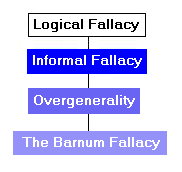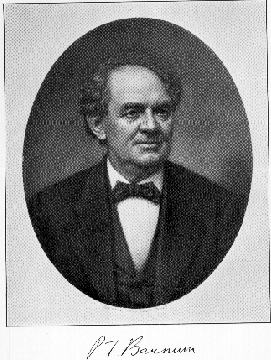 Alias:
Alias:
- The Fallacy of Personal Validation
- The Forer Effect

Etymology:
The psychologist Paul Meehl named this fallacy "the P.T. Barnum effect" because Barnum built his circus and dime museum on the principle of having something for everyone. It is also called "the Forer effect" after its discoverer, the psychologist Bertram R. Forer, who modestly dubbed it "the fallacy of personal validation".
Experiment:
Before reading the Exposition below, try the following experiment:
Exposition:
The Barnum or Forer effect is the tendency for people to judge that general, universally valid statements about personality are actually specific descriptions of their own personalities. A "universally valid" statement is one that is true of everyone—or, more likely, nearly everyone. It is not known why people tend to make such misjudgments, but the effect has been experimentally reproduced.
Exposure:
Many types of personality test or divination work at least partly due to the Barnum Effect. It was first demonstrated using personality descriptions taken from horoscopes, and it is likely that most of the seeming accuracy of astrology is the result of this effect (see French et al. in the Sources, below). However, some popular psychology has also been shown to be the result of the Barnum Effect, for instance, the Rorschach ink blot test. When confronted by a seemingly accurate description of your personality, ask yourself whether it isn't the case that the description is true of most people.
Explanation of the Experiment:
Did the results of the "Spectranality" experiment seem to accurately describe your personality? Did the characteristics appear to be tailored to you, personally? If so, you have just experienced the Forer effect, also known as the Barnum effect. Everyone who checks their "Spectranality" receives the same list of personality characteristics, though the order in which the list is presented differs for the six Spectranality types―one type for each of the following colors: red, orange, yellow, green, blue, and purple. The characteristics were taken from a "universally valid personality sketch" created by D. G. Paterson, as cited by Forer in his paper on the effect (p. 119). The introductory description of "Spectranality" is partially based on the description of a "real" test that is supposed to reveal the secrets of your personality.
Sources:
- Robert Todd Carroll, "The Forer Effect", Skeptic's Dictionary
- Forer, B.R., (1949) "The Fallacy of Personal Validation: A Classroom Demonstration of Gullibility," Journal of Abnormal Psychology, 44, pp. 118-121.
- Christopher C. French, Mandy Fowler, Katy McCarthy & Debbie Peers, "Belief in Astrology: A Test of the Barnum Effect", Skeptical Inquirer, (1991) 15, pp. 166-172.
- C.R. Snyder & Randee Jae Shenkel, "The P.T. Barnum Effect", Psychology Today, March, 1975, pp. 52-54.
Resources:
- Dickson, D.H. & I.W. Kelly, "The 'Barnum Effect' in Personality Assessment: A Review of the Literature," Psychological Reports (1985, Volume 57), pp. 367-382.
- Thiriart, P., "Acceptance of Personality Test Results", Skeptical Inquirer, (1991) 15, pp. 161-165.
